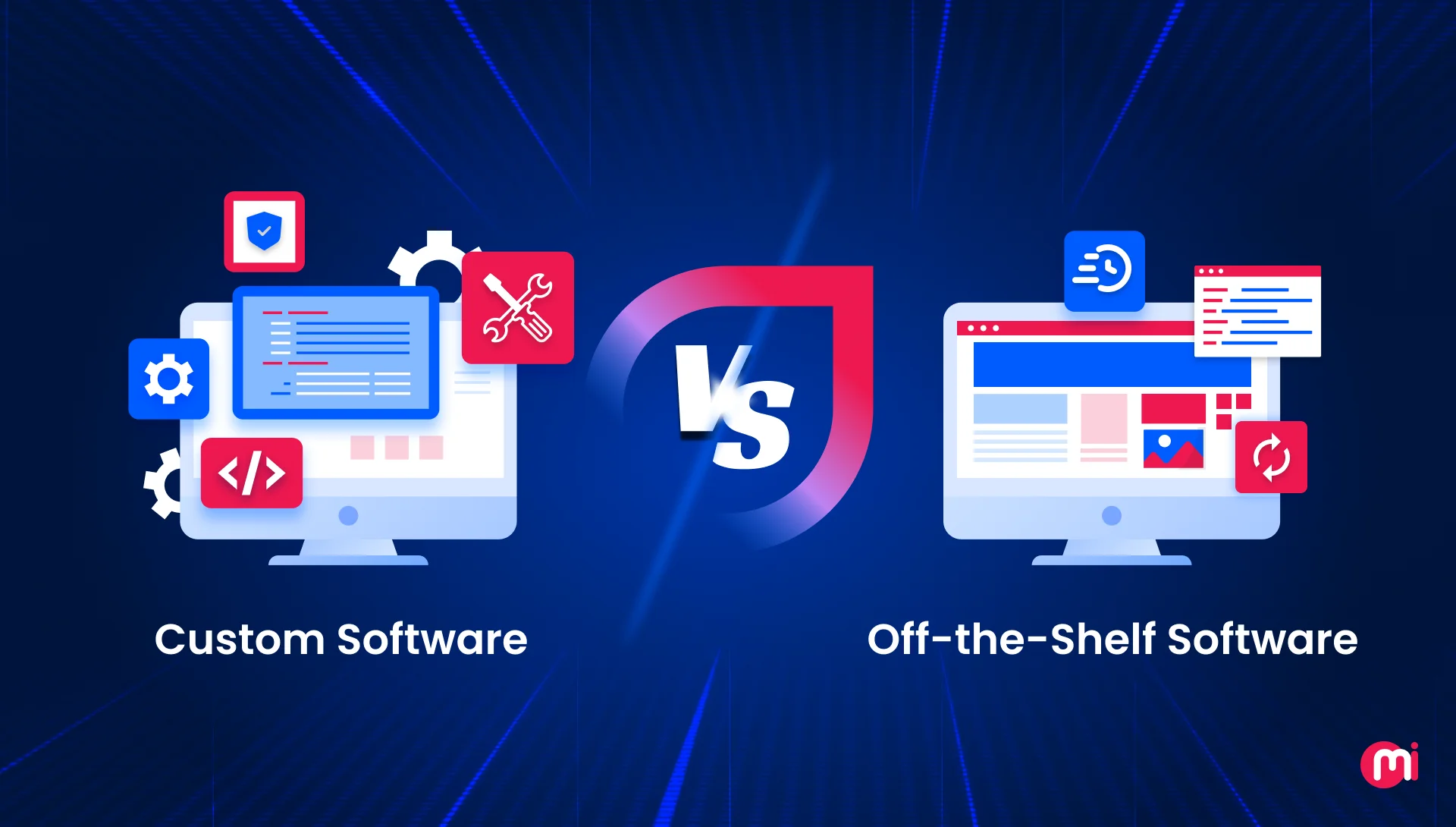Off-the-Shelf Software vs Custom Software: Which is Right for Your Business?
- Mobile
- October 13, 2025
In this competitive business landscape, organizations require software for smooth business operations; however, selecting the right one isn’t always easy. Yes, deciding whether to develop custom software or use off-the-shelf solutions is a question every business must answer to choose the right option.
Software development statistics indicate that the global custom software development market size is projected to reach $146.18 billion by 2030; however, this cannot be the sole reason to choose bespoke software. While custom software is best suited for those who need specific features, off-the-shelf is better for quicker deployment at a lower cost. And, there are many more differences like this.
Read this blog to know the off-the-shelf vs. custom software comparison across key parameters, including their types, pros & cons, and examples. It also contains a detailed comparison section on development approach, time & cost, and flexibility & support, along with a section explaining when to choose what, to give you a clear picture and foster the right software selection.

Key Takeaways
- Custom software is designed from scratch to match unique business workflows, processes, and goals, which can evolve with business growth and adapt to changing requirements.
- Custom software offers unique features and functionalities unavailable in off-the-shelf software while also fitting smoothly with existing systems and infrastructure.
- Off-the-shelf software allows businesses to start immediately at a lower upfront investment compared to custom software.
- Ready-made software comes with ongoing maintenance, updates, and a large user base for support.
- Comparing off-the-shelf software vs custom software to choose one needs a proper consideration of the business’s requirements, budget, and growth plans.
What is Custom Software?
Custom software (also known as bespoke software or tailor-made software) is a kind of software solution designed from scratch to meet the unique needs and specific processes of a single organization or user. This tailor-made approach ensures that the software remains aligned with a business’s goals, workflows, and existing systems.
Custom software provides personalized functionality, excellent efficiency, and a competitive edge, which isn’t available in standard, off-the-shelf software.
Key Characteristics of Custom Software:
- Tailored Functionality: Custom software is developed to solve specific problems and perform tasks that standard software can’t.
- Specific User Focus: Its design and features are inspired by the unique requirements of a user, not a broad audience.
- Developed from Scratch: Custom software is built for a specific client, from its initial design to its final deployment.
- Integration with Existing Systems: This software is designed to integrate seamlessly with a company’s current software and hardware.
What are the Advantages of Custom Software?
- Customized Solutions: Custom software is built specifically to address a business’s unique needs, workflows, and challenges, rather than forcing processes to fit a generic solution.
- Increased Efficiency & Productivity: By automating and optimizing processes & tasks, custom software streamlines operations and boosts productivity.
- Competitive Advantage: Custom software is a unique software solution that sets businesses apart from competitors, as it offers features and functionalities that others don’t have.
- Scalability & Flexibility: When an organization has tailor-made software, it can simply scale it to adapt and meet its evolving business needs, ensuring it remains useful as the company grows.
- Enhanced Security: With custom software, businesses have control over the security features, which enables them to implement measures tailored to their specific risks and data protection requirements.
- Better Integration: Since they’re designed to fit specific needs, custom software solutions are easy to integrate with existing systems, creating a cohesive and efficient digital ecosystem.
- Long-Term Return on Investment (ROI): Although the initial costs are higher, there are numerous benefits of custom software development in the long run, including increased efficiency, cost savings, and improved customer satisfaction. They lead to significant returns.
What are the Disadvantages of Custom Software?
- High Upfront Costs: Building custom software from scratch requires significant financial investment compared to renting an off-the-shelf solution.
- Time-Consuming: The process of planning, designing, and developing bespoke software is likely to take more time than implementing a pre-built product.
- Dependency on Technical Experts: You need to hire software developers with excellence in software design and development for the initial build and for any future updates and maintenance.
- Complex Management: Managing the software development process requires careful planning and oversight, which may be a significant undertaking for a business.
- Potential Support Challenges: If you sever ties with the original development team, it can be tiresome to find ongoing support for your custom software.
- No Standardized Community: Unlike widely used off-the-shelf software, there is no large community or extensive support base available to help when you come across issues with custom software.
Example of Custom Software Solution
Custom software solutions are developed to cater to a business’s specific needs. For example, it can be for any business belonging to any industry, like healthcare, education, finance, sports, real estate, fitness, or else. These solutions may look like:
- A bespoke hospital management system for patient records and billing
- A specialized e-commerce platform built for a unique online business model
- A customized customer relationship management (CRM) system for a specific sales process
- An Enterprise Resource Planning (ERP) software for a manufacturing company
Here’s a real-life example of custom software development:
- Scalable Patient Management System: (A Custom Healthcare Software Solution for Silicon Valley-Based Seed Funded Healthcare Startup)
A seed-funded healthcare startup based in Silicon Valley needed to build an innovative patient management system that could scale as the business grows. The service provider, specializing in software development for startups, builds a robust, compliant, and scalable healthcare solution that delivers enhanced documentation & billing, operational efficiency, scalable growth, and improved patient outcomes.
What is Off-The-Shelf Software?
Off-the-shelf software is a pre-built software product designed for mass commercial use, ready to be purchased and used without customization. Ready-made software solutions come with standard features for a broad user base, making it quick and affordable to implement but potentially limiting it for those with unique business needs.
Key Characteristics of Off-the-Shelf Software:
- Pre-Packaged: Off-the-shelf software is pre-developed and ready for immediate use.
- Generic: It’s built to serve a wide range of users and their common needs rather than a specific business’s requirements.
- Commercially Available: Off-the-shelf software can be licensed or purchased quickly from a service.
- Standardized: Ready-made software has predefined features and functionalities.
- Vendor-Supported: For off-the-shelf software, the developer typically provides ongoing support, updates, and bug fixes.
What are the Advantages of Off-The-Shelf Software?
- Speed and Cost: Off-the-shelf software is faster to deploy, as it is ready-made, and often less expensive to implement compared to custom-built solutions.
- Convenience: This software is readily available and requires no extensive development work.
- Vendor Support: Users benefit from the ongoing assistance from the service provider for needs occurring down the line.
- Community: Since off-the-shelf software solutions have a wider user base, you often have a large user community for support and resources.
What are the Disadvantages of Off-The-Shelf Software?
- Lack of Customization: The “one-size-fits-all” approach is less likely to fully address your business’s unique processes or requirements.
- Potential for Compromise: You might need to adjust your workflows to fit the software’s limitations.
- Compatibility Issues: Integrating off-the-shelf software with existing or specialized systems can sometimes be difficult.
- Hidden Costs: There may be hidden costs, like licensing fees, costs for additional users, or charges for extra features, likely to increase the total cost of ownership.
Examples of Off-The-Shelf Software Solutions
There are many off-the-shelf software examples; however, CollabCRM, Salesforce, and Microsoft 365 are a few of the examples worth discussing. Here’s all about these ready-made software solutions:
1. CollabCRM
CollabCRM is an example of an off-the-shelf software solution. It’s a ready-to-use work management software, designed specifically for IT companies. CollabCRM brings together many modules, including People management, Project management, CRM & Invoice management, and Recruitment management, to ease the daily hassle of IT companies, ensuring a smooth business operation.
The right tool is the one that solves your problem today, without reinventing the wheel
— Mehul Rajput, CEO of MindInventory.
2. Salesforce
Salesforce is a customer relationship management (CRM) platform that comes embedded with a suite of tools for analytics, sales, customer service, marketing automation, and application development.
Designed to serve businesses of all sizes, Salesforce empowers companies to connect with customers, gain insights into their behavior, and deliver personalized experiences through features like Sales Cloud, Service Cloud, and Marketing Cloud.
3. Microsoft 365
Microsoft 365 is an off-the-shelf software package, which includes widely-used applications like Microsoft Word for document creation, Excel for spreadsheets, Outlook for email communication, and PowerPoint for presentations.
It features desktop, web, and mobile versions of Word, Excel, PowerPoint, and Outlook, along with OneDrive cloud storage, Microsoft Teams for seamless collaboration, and additional applications like Forms and Planner.
What are the Differences Between Custom Software and Off-the-Shelf Software?
There are numerous differences between custom and off-the-shelf software. Be it design, development, scaling, cost, maintenance, approach, users, and so on, both types of software solutions are largely different from each other.
Here’s the detailed examination of off-the-shelf software vs custom software you should know to get a clear picture:
| No. | Feature/Aspect | Custom Software | Off-the-Shelf Software |
| 1. | Definition | Built specifically for an organization’s needs | Ready-made software available to the public |
| 2. | Cost | Higher upfront cost; long-term investment | Lower initial cost; may have subscription fees |
| 3. | Deployment Time | Longer development and testing period | Quick or immediate deployment |
| 4. | Flexibility & customization | Highly flexible; tailored to exact requirements | Limited flexibility: fixed features |
| 5. | Maintenance & Support | Depends on the developer or the in-house team | Offered by the service provider |
| 6. | Integration | Can integrate seamlessly with existing systems | May require add-ons or workarounds |
| 7. | Risk | Risk of delays, cost overruns, and bugs | Risk of unused features or dependency on the service provider |
| 8. | Scalability | Can grow and adapt with scaling business needs | Limited scalability; may need upgrades or replacements |
| 9. | Application Areas | Large enterprises, niche industries, complex workflows | SMEs, standard business functions (CRM, accounting, productivity) |
| 10. | Advantages | Tailored solution, competitive advantage, seamless integration | Cost-effective, quick deployment, stable, and tested |
| 11. | Disadvantages | Expensive, longer implementation, and developer dependency | Less flexible, may include unnecessary features, and potential compatibility issues |
1. Software Development Approach
Custom Software: Since it aims to cater to unique business needs, custom software is designed and developed from scratch, aiming to match that organization’s unique workflows, processes, and requirements.
Inspired by the goal, every feature of a custom software is intentionally built for that business, ensuring no unnecessary extras. Custom software is developed after analyzing the necessity.
Off-the-Shelf Software: In contrast to custom software, off-the-shelf software is a prebuilt solution with standardized features designed to serve a broad range of businesses. Although convenient to integrate, ready-made software often requires companies to adjust their processes to fit the software rather than the other way around. Off-the-shelf software is pre-built software, focusing on mass users.
2. Implementation Time and Cost
Custom Software: Since it involves discovery, design, coding, testing, and deployment, custom software development takes longer to deploy. Besides, the cost of custom software development is higher upfront; however, the investment pays off with long-term alignment with your business goals.
Off-the-Shelf Software: Since they’re ready-made, off-the-shelf software solutions are quick to deploy and cheaper initially. However, recurring subscription fees, licensing, and costs for add-ons are more likely to add up over time.
3. Flexibility and Scalability
Custom Software: Custom software is tailored to specific business needs; hence, they are completely flexible and scalable, and can seamlessly evolve alongside your business. You can add new features or adapt the system whenever you feel your business operations have started to grow.
Off-the-Shelf Software: As they aim to cater to different audiences, off-the-shelf software offers limited flexibility. You may need workarounds or third-party integrations to accommodate growth or new needs. These solutions are less flexible and scalable compared to custom software.
4. System Integration
Custom Software: Custom software is developed to integrate seamlessly with your existing tools and infrastructure; hence, it’s easy to integrate and minimizes friction while increasing efficiency.
Off-the-Shelf Software: With off-the-shelf software, integration depends on the service provider. Some products offer APIs or plugins; however, you may require additional tools, and even then, compatibility isn’t always guaranteed.
5. Maintenance & Support
Custom Software: With custom software, maintenance and updates rely on your software development company. Although the support can be highly personalized, it requires ongoing commitment and expenses.
Off-the-Shelf Software: Ready-made software typically includes vendor-provided support, bug fixes, and regular updates; however, these are standardized and may not fully address your unique needs.
6. Project and Operational Risks
Custom Software: There are many project and development risks in custom software development. These include development delays, budget overruns, or bugs in early versions. However, once stabilized, it becomes a long-term strategic asset.
Off-the-Shelf Software: These solutions come with lower development risk, but your business faces dependency on the service provider. If the service provider discontinues the product or changes pricing, it is likely to disrupt operations.
7. User Adoption & Training Requirements
Custom Software: In the case of custom software, you may require training since the solution is designed around your processes. However, once adopted, it continues to improve efficiency significantly.
Off-the-Shelf Software: Off-the-shelf software solutions are easier for teams to adopt since interfaces are often standardized and widely used. However, users may need to adapt their workflows to fit the software’s limitations.
Custom Software vs. Off-the-Shelf: When to Choose What
Before choosing between custom and off-the-shelf software, gauge your business needs and conclude which one to choose. For example, custom software enables seamless incorporation into established technology ecosystems, whereas off-the-shelf options might require additional integration. So, read through the pointers below to conclude:
1. Budget Constraints
If you’ve budget constraints and want to save in the beginning, choose off-the-shelf software. However, custom software development will be beneficial and cost-effective in the long run. That’s because custom software requires a higher upfront investment but can deliver greater long-term value by eliminating recurring license costs and unnecessary features.
Off-the-shelf software, on the other hand, is more affordable initially, though ongoing subscription or licensing fees can add up over time. So, choose off-the-shelf software when you need lower upfront costs and quicker implementation, and go with custom software when you prefer long-term benefits.
2. Timeline Requirements
Choose off-the-shelf software when you need a solution immediately and want to avoid the high upfront costs of custom development. Off-the-shelf software is ready for immediate use, and you can use it immediately, saving valuable time.
If your business’s individuality overpowers the timeline, custom software development is the way to go. It takes longer, as it involves discovery, design, coding, testing, and training before rollout. It may take time; however, custom software will be best suited for your unique business.
3. Specific Business Needs
If your business has specific workflows or requirements that off-the-shelf software can’t accommodate, and you want features and functionalities that set your business apart from competitors, choose custom software development. If you need AI-enabled functionalities, you can do it by leveraging AI software development services.
You can opt for off-the-shelf software if you can run the business with a generic software solution. They usually cater to common needs and may not fully address industry-specific processes without significant customization.
4. Expected Growth and Scalability
Custom software development is best if you anticipate significant growth and need a software solution that can scale with your expanding needs. For those businesses planning rapid growth or digital transformation, custom software offers scalability and the flexibility to add features over time.
Off-the-shelf solutions, on the other hand, may limit expansion, forcing companies to upgrade or switch platforms down the line.
5. Integration with Existing Systems
When integration with your existing system overrides other needs, and you need seamless integration between multiple existing systems and applications, choose custom software development.

FAQs on Off-the-Shelf Software vs Custom Software
Off-the-shelf describes any software solution, usually a commercial one, developed for the mass market. It is a ready-made software product, like Salesforce and CollabCRM, that you can use for your needs without building one from the ground up.
Cost-effectiveness and faster deployment are the two key advantages of off-the-shelf software. These software solutions are generally more affordable upfront because the development costs are borne by a large user base. Being pre-built makes them ready to use, saving time and ensuring quicker deployment.
Custom software is made only for one company, tailored to its needs; off-the-shelf software is a ready solution developed to be used by numerous businesses sharing common interests and standardized processes.
Yes, off-the-shelf software can often be customized through configuration of its standard features, but full, deep customization is generally limited and may not meet unique business needs, potentially requiring businesses to adapt their processes to the software instead. Although some off-the-shelf solutions offer modules or add-ons to meet specific needs, they are not as flexible as custom-built software.
Custom software development may seem to be expensive upfront; however, due to its many benefits, it proves to be cost-effective down the line. Off-the-shelf software has less upfront cost, but it may be costly when you need additional features and functionalities to scale.













